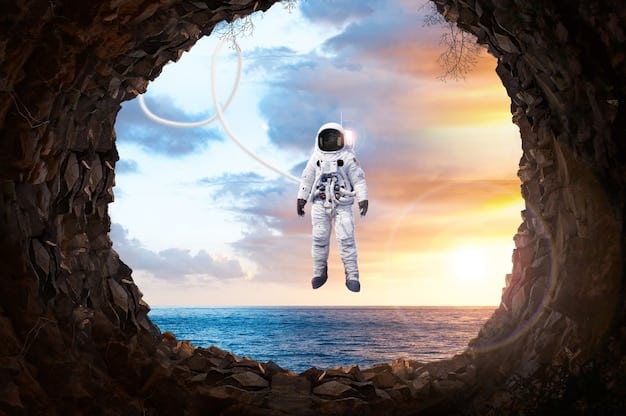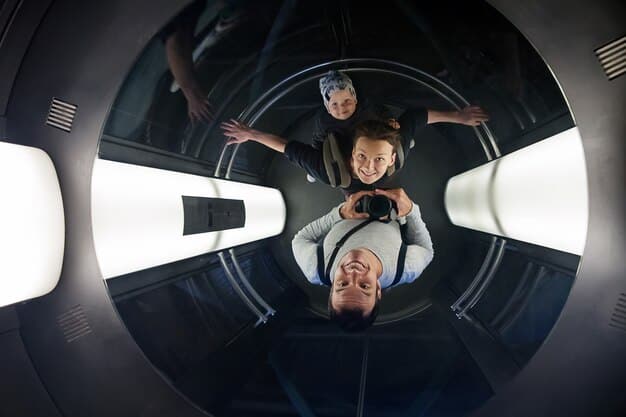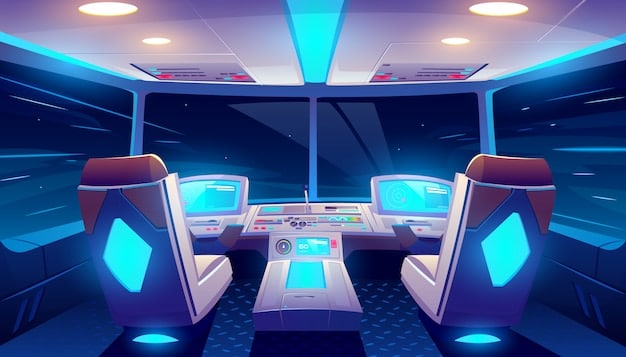Space Tourism for US Citizens: A 5-Year Outlook

Exploring the potential of space tourism for US citizens in the next 5 years reveals a burgeoning industry poised for growth, driven by technological advancements, increasing accessibility, and a growing desire for unique experiences beyond Earth.
The dream of traveling to space, once confined to science fiction, is rapidly becoming a tangible reality. Exploring the potential of space tourism for US citizens in the next 5 years requires examining the technological advancements, economic factors, and regulatory landscapes that are shaping this exciting new frontier.
The Current State of Space Tourism
Space tourism is no longer a distant fantasy. Several companies have already made significant strides in offering suborbital and orbital flights to paying customers. Understanding the current landscape is crucial for anticipating future developments and assessing the potential impact on US citizens.
Existing Space Tourism Companies
Several key players are currently shaping the space tourism market. These companies offer different types of space experiences, ranging from brief suborbital flights to extended stays on orbital stations.
- Virgin Galactic: Offers suborbital flights providing a few minutes of weightlessness and stunning views of Earth.
- Blue Origin: Provides suborbital flights with similar experiences, focusing on safety and accessibility.
- SpaceX: Aims to offer orbital and even lunar tourism, with longer stays and more extensive training.

These companies have demonstrated the feasibility of commercial space travel and have paved the way for future growth. The success of these initial ventures will greatly influence the expansion and accessibility of space tourism for US citizens in the coming years.
Technological Advancements Driving Space Tourism
Advancements in rocket technology, spacecraft design, and life support systems are making space travel safer and more affordable. These innovations are critical to expanding the reach of space tourism and making it accessible to a wider audience of US citizens.
Reusable Rocket Technology
Reusable rockets, pioneered by companies like SpaceX, drastically reduce the cost of space travel by allowing rockets to be used multiple times.
This innovation is paramount for making space tourism economically viable for the general public. By lowering the cost per launch, companies can offer more affordable tickets and open the door to a larger market of potential space tourists.
Improved Spacecraft Design
Modern spacecraft are designed with passenger comfort and safety in mind. They incorporate advanced life support systems, spacious cabins, and large windows for optimal viewing experiences.

These design improvements enhance the overall experience of space tourism, making it more appealing to a broader range of individuals. Comfortable and safe spacecraft are essential for attracting US citizens who may be hesitant about the risks associated with space travel.
In conclusion, technological advancements are pivotal in driving the growth of space tourism. Innovations such as reusable rockets and improved spacecraft design not only reduce costs but also enhance safety and comfort, making space travel increasingly accessible to US citizens.
The Economic Landscape of Space Tourism
The economic factors surrounding space tourism are complex, involving high upfront costs, potential revenue streams, and the creation of new industries. Understanding the economics is crucial for evaluating the long-term sustainability and growth potential of space tourism for US citizens.
High Initial Investment
Developing and launching space tourism ventures requires significant capital investment. This includes funding for rocket development, spacecraft construction, and infrastructure development.
These high costs can be a barrier to entry for new companies and can limit the growth of the industry. However, as technology advances and economies of scale are achieved, the costs are expected to decrease over time.
Potential Revenue Streams
Space tourism generates revenue through ticket sales, in-flight services, and merchandise. Additionally, it can stimulate growth in related industries such as hospitality, transportation, and entertainment.
The potential revenue streams are substantial, attracting investors and driving further innovation in the space tourism sector. As more US citizens participate in space tourism, the economic benefits will become more apparent.
In conclusion, the economic landscape of space tourism is characterized by high initial investment and significant potential revenue streams. The long-term success of the industry will depend on attracting investment, managing costs, and capitalizing on the various revenue opportunities that arise.
Regulatory and Legal Considerations
The space tourism industry is subject to various regulations and legal frameworks, both domestically and internationally. These regulations aim to ensure safety, protect the environment, and address liability issues. Understanding these considerations is vital for responsible and sustainable growth.
Safety Regulations
Governments and regulatory bodies are developing safety standards for space tourism operations. These regulations cover everything from spacecraft design and testing to astronaut training and emergency procedures.
- Ensuring passenger safety is paramount.
- Comprehensive regulations are crucial for building public trust and confidence in the industry.
- Continuous improvement in safety standards is essential.
Environmental Impact
Space tourism activities can have environmental consequences, including air pollution from rocket launches and potential impacts on the upper atmosphere.
Efforts are underway to mitigate these impacts through the development of cleaner rocket fuels and sustainable launch practices. Minimizing the environmental footprint of space tourism is essential for long-term sustainability and public acceptance.
In conclusion, regulatory and legal considerations play a crucial role in shaping the future of space tourism. Establishing clear safety regulations and addressing environmental concerns are essential for ensuring the responsible and sustainable growth of the industry, particularly concerning US citizens’ participation.
The Potential Impact on US Citizens
Space tourism has the potential to significantly impact US citizens, both directly and indirectly. From creating new jobs and economic opportunities to inspiring future generations of scientists and engineers, the benefits are wide-ranging.
Job Creation
The space tourism industry will create new jobs in various sectors, including aerospace engineering, tourism management, and hospitality.
These job opportunities will contribute to economic growth and provide new career paths for US citizens with diverse skills and backgrounds. The growth of space tourism will stimulate innovation and entrepreneurship, leading to further job creation.
Educational Opportunities
Space tourism can inspire young people to pursue careers in science, technology, engineering, and mathematics (STEM) fields.
By showcasing the excitement and potential of space exploration, it can motivate students to excel in STEM subjects and contribute to future advancements in space technology. The educational impact of space tourism can help the US maintain its leadership in aerospace and technology.
In conclusion, space tourism has the potential to positively impact US citizens in numerous ways, from creating new jobs and stimulating economic growth to inspiring future generations of scientists and engineers. Realizing these benefits requires strategic investment, supportive policies, and ongoing collaboration between government, industry, and academia.
Challenges and Opportunities for Growth
Despite its vast potential, space tourism faces several challenges that must be addressed to ensure sustainable growth. These challenges include high costs, safety concerns, and environmental impacts. Overcoming these hurdles will unlock significant opportunities for expansion and innovation.
Reducing Costs
One of the biggest challenges is reducing the cost of space travel. This can be achieved through technological advancements, economies of scale, and innovative business models.
- Investing in reusable rocket technology is crucial.
- Streamlining operations and reducing overhead costs are essential.
- Exploring public-private partnerships can help share the financial burden.
Addressing Safety Concerns
Ensuring passenger safety is paramount for building public trust and confidence in space tourism. This requires stringent safety regulations, rigorous testing, and continuous improvement in safety protocols.
Transparency and open communication about safety measures are also essential for addressing concerns and fostering a culture of safety within the industry. Collaborating with international partners to share best practices and develop common safety standards can further enhance safety.
In conclusion, addressing the challenges and capitalizing on the opportunities will be crucial for realizing the full potential of space tourism for US citizens in the next 5 years and beyond. Proactive measures to reduce costs, ensure safety, and mitigate environmental impacts will pave the way for a sustainable and thriving space tourism industry.
| Key Takeaway | Brief Description |
|---|---|
| 🚀 Tech Advances | Reusable rockets cut travel costs. |
| 💼 Economic Impact | Space tourism creates jobs and boosts related industries. |
| 🛡️ Regulation | Safety standards and environmental protection are vital. |
| 👨🚀 US Citizens | Space tourism can inspire STEM careers. |
Frequently Asked Questions
▼
Current prices range from $450,000 for a Virgin Galactic suborbital flight to millions for orbital experiences with SpaceX. Costs are expected to decrease as technology advances and competition increases.
▼
Space tourism involves risks, but companies prioritize passenger safety. Stringent safety regulations, rigorous testing, and astronaut training are implemented to minimize potential hazards.
▼
Space tourists must undergo medical evaluations to ensure they are fit for space travel. Companies have specific health requirements, including cardiovascular health and the ability to withstand G-forces.
▼
Rocket launches can contribute to air pollution and impact the upper atmosphere. Efforts are underway to develop cleaner rocket fuels and sustainable launch practices to mitigate environmental effects.
▼
Preparation may include medical check-ups, physical training to withstand G-forces, and familiarization with spacecraft procedures. Companies provide training programs to help tourists prepare for their space journey.
Conclusion
Exploring the potential of space tourism for US citizens in the next 5 years reveals a promising future marked by technological advancements, economic opportunities, and inspiring possibilities. As the industry overcomes its challenges and embraces sustainable practices, space tourism is poised to transform our perception of space travel and its accessibility.





